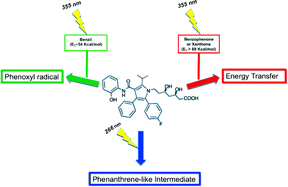The influence of the phenolic hydroxyl group of ortho-hydroxy atorvastatin metabolite (Ato-OH) on the photochemistry of atorvastatin (Ato) has been evaluated by steady and time-resolved experiments. Direct excitation of Ato and Ato-OH led to phenanthrene-like intermediate formation, being ∼30% for Ato-OH less efficient than that for its parent compound in methanol. Both, Ato and Ato-OH are able to quench benzophenone (ET ∼69 kcal mol−1) and xanthone (ET ∼74 kcal mol−1) triplet excited state with rate constants close to diffusion limit control which suggest energy transfer mechanism is taking place. In fact, lower triplet energies ∼63 kcal mol−1 and π,π* character, were confirmed by DFT calculations for both compounds. Interestinlgy, only Ato-OH can act as a hydrogen donor towards triplet benzil excited state (ET ∼ 54 kcal mol−1) due to the presence of the phenolic hydroxyl group. Nevertheless, the presence of this group in Ato-OH does not modify to a significant degree the compound reactivity toward singlet oxygen. The importance of triplet energy transfer in biological systems to form Ato and Ato-OH triplet excited state as well as the hydrogen donor capacity of Ato-OH toward triplet excited state are discussed in the present communication.

